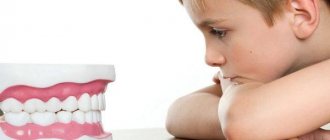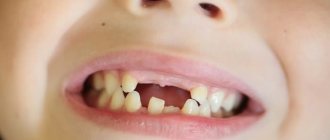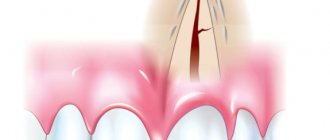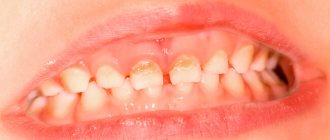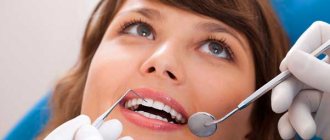Causes
Dental hypoplasia occurs due to metabolic disorders in the fetal body at the stage of intrauterine development, as well as when exposed to negative external factors. In children, hypoplasia is often caused by:
- Rh conflict between mother and child;
- infectious diseases, acute respiratory viral infections, suffered by the mother during pregnancy;
- toxicosis, gestosis, birth trauma, premature birth;
- unbalanced nutrition of the mother, taking medications while carrying a child.
Anomalies in the development of the enamel of children's teeth often occur against the background of rickets, encephalopathy, and atopic dermatitis. Hypoplasia also affects permanent teeth: disturbances appear during the formation of the rudiments of permanent dental units.
Causes of dental pathologies in adolescents and adults:
- injuries of the maxillofacial area;
- endocrine diseases, anemia;
- pathologies of the digestive, urinary or nervous system.
Also, the condition of teeth is affected by a lack of vitamins and microelements, the use of tetracycline drugs, excess fluoride in drinking water and other factors.
Ask a Question
Characteristic symptoms
The main symptoms of the pathology include a change in the color of the enamel: white spots appear on the outer surface. Such changes do not cause unpleasant feelings. In addition, the surface of the teeth in the affected areas is smooth and non-pigmented.
More severe forms of hypoplasia are characterized by the presence of pronounced depressions. At the initial stages, the lesions have a natural shade, but over time they become pigmented. Sometimes on such teeth you can notice deep grooves located horizontally or vertically. Despite the hyperpigmentation of certain areas, the integrity of the enamel is not compromised.
Aplasia (complete absence of enamel) is characterized by pain upon contact with any irritant. In addition, aplasia is associated with underdevelopment of dentin. This leads to the fact that the teeth gradually begin to change shape.
Dental treatment for children at an early age
A one-year-old baby may need dental care. During this time he is teething, which can be very painful. During this period, the dentist recommends special pain-relieving gels and anti-inflammatory drugs. He teaches parents how to care for their baby’s teeth, recommends special brushes that fit on an adult’s finger and toothpastes.
Dental treatment for children under 3 years of age
A two-year-old child already has most of his baby teeth. At the same time, the first signs of carious lesions appear. From this age, non-invasive preventive therapy for caries is carried out. For this purpose, silvering, fluoridation and mineralization are used. After this treatment, the dentinal canals are closed. This stops the spread of carious infection deep into the tissues to neighboring teeth.
How to treat a 3 year old child
At this age, the baby begins to have all the milk in the amount of twenty pieces. Children show great interest in sweets, which accelerates the spread of tooth decay. The first carious cavities appear in babies. They try to treat them without using a drill.
The following methods are used:
- Ikon technology - using a special chemical, the area affected by caries is treated. The tissue softens and can be removed mechanically.
- Drilling using air-kinetic installations. They use a directed jet of water containing abrasive powder to remove affected dentin. The jet is released under pressure.
- Ozonation – tissue affected by caries is treated with active oxygen, which penetrates well inside. It kills bacteria.
- ART technologies – affected dentin is removed using special ceramic instruments without drilling.
To prevent caries, fissures are sealed.
Dental treatment for children 4 years old
At this age, caries is complicated by pulpitis if timely treatment is not carried out. In this case, partial removal can be carried out, while it is better to preserve the root part of the pulp. In rare cases, a tooth is removed, which is extremely undesirable. In order for children to develop a correct bite, it is advisable to preserve all milk products.
Types and features of dental hypoplasia
Based on clinical manifestations, several forms of pathology are distinguished:
- Erosive . Oval or round defects appear on the surface of the teeth. Damage comes in different sizes. They are often covered with a thin layer of enamel, and dentin can be seen inside the recesses.
- Wavy . The appearance of multiple horizontal lines on the outer surface of the teeth.
- Spotted . The structure of the enamel itself does not change, but white or yellowish spots appear on it.
- Sulcata . Grooves of varying depths parallel to the cutting edge of the tooth.
- Aplastic . Almost complete absence of tooth enamel - only small areas of the teeth are covered with it.
- Mixed . A combination of several forms, for example, erosive and wavy.
Depending on the severity, the disease can be systemic or local. In the first case, erosive pathology affects many teeth in the upper and lower jaw. In the second, the lesions are point-like and appear on one or two teeth.
Systemic hypoplasia
Pathological changes of a systemic nature are reflected in the shape of the dental units. They are classified into several types:
- Hutchinson's teeth . The anomaly affects the central upper incisors - with pathology, they have a barrel shape. There is a semicircular notch on the cutting edge.
- Pflueger's teeth . As a rule, permanent molars are subject to changes. They are barrel-shaped and have a poorly developed chewing surface. The shape of Pflueger's molars is very similar to cones.
- Fournier's teeth . The dental units look like Hutchinson's sign, but there are no characteristic grooves below.
Local hypoplasia
Local hypoplasia of tooth enamel occurs due to problems with baby teeth, inflammatory processes during the formation of the rudiments of permanent teeth, mechanical injuries to the jaw, and infections. Pathology often manifests itself in the form of shallow stripes or spots.
If children's teeth are crumbling...
Teeth change color and become extremely sensitive to hot and cold: as soon as children have permanent teeth, many already suffer from so-called molar hypomineralization (MIH).
This is a special form of disruption of the formation of tooth enamel. First of all, this disease affects the chewing teeth. But incisors can also suffer from this disease.
A lack of minerals makes teeth porous. Teeth affected by MIH have fewer minerals present than are present in healthy teeth. First of all, they have a lower concentration of calcium and phosphates. As a result, teeth become porous, and this, in turn, leads to very rapid development of caries.
When affected molars erupt in schoolchildren, molar hypomineralization is now diagnosed quite simply. But just a few years ago the situation was completely different, since this form of diagnosis simply did not exist yet.
The picture of the disease has only recently been described. It was not until 2001 that this phenomenon was brought together under the term Molar Incisor Hypomineralization (MIH), that is, “mineral deficiency in the molars and incisors.”
This approach has significantly improved the diagnosis of children's and adolescent teeth. After all, before this, it was very difficult for the dentist to determine whether the tooth was porous even before the onset of the disease or whether it was a matter of ordinary caries.
Every tenth child has problems with the formation of tooth enamel. Doctors say that the problem of MIH affects ten percent of children, and in five percent it manifests itself in a severe form, accompanied by significantly increased sensitivity and loss of substance.
In adults, it is much more difficult to assess the extent of molar hypomineralization. Even if they had manifestations of MIH, the teeth affected by this disease in most cases have already undergone treatment and restoration, for which reason an appropriate diagnosis is no longer possible.
The causes of MIH should probably be sought in pregnancy. It has not yet been possible to determine where MIH originates from. Doctors admit that they can only guess about the causes of this disease. For example, problems during pregnancy are considered, which could theoretically have a negative impact on dental development.
In addition, events that occur in early childhood, such as high fever infections, antibiotic use and respiratory diseases, as well as dioxin in breast milk, are also suspected. It is possible that the cause of MIH is a combination of several different factors.
Doctors use different methods to treat molar hypomineralization. If MIH is detected in the early stages, the teeth are usually “sealed,” meaning they are coated with a special compound. In more complex cases, fillers and even crowns are used.
Treatment: special dental care, in some cases – removal. In some severe cases of violations of the formation of tooth enamel, the decision remains with the doctors: does a particular tooth have the prospect of long-term preservation? But if a tooth still has to be removed, it should be taken into account that the issue of filling the vacated space must be resolved as soon as possible, since in this case, due to the increased load, neighboring teeth will also suffer.
And you should remember: if children suffer from problems with the formation of tooth enamel, they should brush their teeth only with soft toothbrushes, using fluoride-containing toothpastes.
Treatment tactics
Hypoplasia of the enamel of primary or permanent teeth is irreversible. Therefore, all therapeutic measures are aimed at protecting the altered areas of the dentition and restoring the enamel coating. Mild pathology does not require special treatment, but only requires constant monitoring. In most cases, a person does not experience pain: non-carious changes in dental tissues do not interfere with everyday life.
For severe forms of hypoplasia, for example, deep lesions of the enamel or extensive spots, special therapy is carried out. Without timely treatment, there is a risk of developing various complications:
- pulpitis, periodontitis;
- malocclusion;
- pathological abrasion;
- increased sensitivity of teeth.
Hypoplasia can also lead to dentin destruction and complete tooth loss. There are several methods for eliminating the manifestations of hypoplasia. Therapeutic tactics are selected by the dentist depending on the severity of the pathology. The doctor takes into account the condition of the patient’s dental tissues.
Remineralization
Remineralizing therapy involves saturating tooth enamel with fluoride and calcium. Artificial mineralization is carried out using dental gels, pastes, varnishes and other means. Treatment can be done in a clinic or at home.
Remineralization in a clinical setting consists of several stages:
- Professional oral hygiene.
- Application of restorative gel.
- Coating with a fluorine-containing compound using a tray or brush.
The dentist selects the frequency of procedures and the type of drug individually. In addition, your doctor will often prescribe oral vitamins and minerals as additional support for your body.
Whitening
Bleaching is carried out after professional hygiene and remineralizing therapy. This method is effective if the defects are located in the surface layers of the enamel or slight clouding of the enamel layer is observed. Chemical bleaching gives the most pronounced results.
In cases of severe damage to the enamel layer and numerous foci of hypoplasia, chemical bleaching with solutions of carbamide peroxide and hydrogen peroxide is contraindicated.
Filling and prosthetics
Filling is used for pronounced erosive depressions, as well as mixed forms of hypoplasia, when the integrity of the dental units is compromised. Composite materials are used to restore teeth. In some cases, the vestibular surface is covered with veneers. This technique helps to give teeth an aesthetic appearance and prevent their destruction.
Prosthetics are used for severe damage to the enamel of primary or permanent teeth. Crowns help maintain the health and aesthetics of your teeth. Installing crowns for hypoplasia in childhood contributes to the formation of a correct bite and the development of normal diction.
Depending on the extent of the damage, the condition of the soft and hard tissues, it may be necessary to remove the affected tooth followed by implantation.
Treatment of baby teeth
Treatment of baby teeth requires a special approach, since children tend to be afraid of dentists and any, even the most harmless, procedures. I recommend taking children to the dentist for preventive examinations from early childhood. This helps prevent fear from forming. My youngest patients are two-month-old babies who are still basically devoid of teeth.
A timely visit to a doctor in our pediatric dentistry office allows you to keep your tooth intact and healthy. In the early stages, when caries is in the white spot stage, and there are no visible defects or pain, tooth enamel can be restored with the help of special therapy using mineral components. This is a simple, safe and comfortable procedure.
Child caries develops more rapidly than adults, so in no case should you hesitate to contact a specialist. Otherwise, the bacteria will reach the pulp, the most sensitive part of the tooth, through which all the nerves and blood vessels pass, and the child will begin to experience constant acute pain. Treatment will take a longer period of time and may cause an upset child to develop a visceral fear of dentists simply because of the discomfort. It is almost impossible to establish contact with an anxious child.
But there is nothing complicated in the procedure itself. After examining the damaged tooth in which a cavity has formed, the doctor uses special instruments to remove all carious tissue and restore the tooth with filling material. Today, all such manipulations are performed under local anesthesia.

